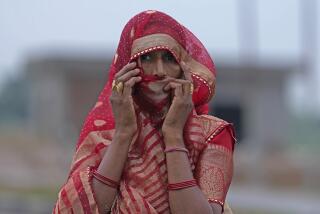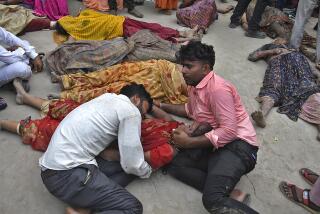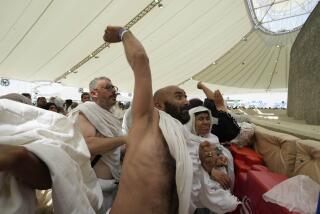Hindus Celebrate Salvation by Bathing in Ganges : India’s Holiest, Deadliest Festival Opens
- Share via
HARDWAR, India — Once every 12 years, when the planet Jupiter reaches just the right spot in Aquarius, Indian Hindus stage their largest, holiest and most dangerous festival in Hardwar on the banks of the sacred Ganges River.
It is a celebration of salvation, a time when Hindus believe that they can end the cycle of reincarnation by bathing in the holy river. It is also a spectacle where every stripe of Hindu holy man, some naked and covered with ashes, others resplendent atop gilded palanquins, stage one of the strangest, gaudiest parades in the world.
All too often it is also a time of tragedy. Monday was no exception. At least 46 Hindu pilgrims were trampled to death in the gigantic crowd that assembled here.
The deaths, mostly of women and small children, happened early Monday morning only three hours after the Kumbh Mela festival reached its most sacred period, the time that Hindus feel is most auspicious for achieving moksha --liberation from the flesh into a holy spiritual sphere.
Bathe in Frigid Waters
For 20 hours, beginning at exactly 2:06 a.m. on Monday, bathing in the frigid waters of the snow-fed Ganges in Hardwar carries Hindu religious merit equivalent to circling the Earth 100,000 times or giving 100 cows to a Brahmin priest.
As pilgrims rushed to reach the most sacred bathing ghat , a sloping concrete bank called har ki pauri (staircase to Lord Shiva), a restraining barricade broke in front of a bridge leading across the river to the bathing spot. Police were unable to control the frenzied, onrushing crowd, and the victims were crushed.
“It was a stampede on the main bridge,” said Ravind Tyagi, a Uttar Pradesh state official asigned to the festival. Most of the victims died of suffocation, doctors told reporters.
It was not the first nor even the worst such incident in Hardwar. More than 100 died in Hardwar in the 1950 festival.
Attracts 4 Million
More than 4 million pilgrims come to Hardwar for the Kumbh Mela. Each time it occurs, it is one of the largest gatherings of human beings ever assembled. More people gathered in Hardwar on Monday than attended Dodgers games at Chavez Ravine throughout the baseball season last year--3,264,593, according to a Dodgers spokesman.
Hardwar is celebrated as one of the four places on the Ganges River where Jayant, son of the god Indra, spilled a drop of ambrosia having the power to free the soul from a pitcher called a “kumbh.” But unlike the other three locations--Ujjain, Nasik, Alahabad--Hardwar is surrounded by steep hills; here pilgrims encounter a swifter Ganges, swollen with melting snows from the nearby Himalays.
No matter how many police--10,000 this year--or temporary bridges--eight--the Indian government builds to control the crowds here, too many Indians crowd into too little space. As it is, only an estimated 1 1/2 million of the 4 million pilgrims are able to bathe in the river during the so-called “auspicious” times.
Tragedy Ignored
The tragedy by the bridge Monday had little effect on the joyous celebration by the millions of other pilgrims. It was as though all discord, all possible sorrow had been swept away by the river; the cries of the victims were drowned out by the roar of the rapids.
Bodies of the victims were stretched in rows behind Har Milap Hospital. According to Hindu belief, they were almost certain to be reincarnated in another life form, perhaps as a human, but possibly as a cow or an insect or even a rat.
But for those who had made it to the river for bathing, it was an ecstatic moment. Mothers gently cradled their children and dipped them as ministers from a Christian church in the American South might--total immersion. Smiling sisters clutched each other for stability in the stiff current and took turns bobbing until they looked like human pumps. Aging husbands beamed as aging wives entered the water, perhaps reassured that their spouses, too, would now be freed from the fears of a sorrowful future.
Included in the bathers Monday was a Texas oilman, Tom Cantwell, 59, an oilfield supplier from Houston. Cantwell said he had been on a mountain-climbing expedition with his son-in-law, Bruce Macler, 31, a botany professor at UC Berkeley, when he heard about the big festival in Hardwar.
“The oil business has been terrible,” Cantwell said. He joked that by dipping in the Ganges, some of the Hindu gods might be able to “raise oil prices.”
‘Just Hoping,’ Oilman Says
“Just hoping,” he said, his body half submerged in the blue-green water. “When you are in the oil business, you take all the chances.”
After noon on Monday, the holiest day ofthe kumbh mela, the bathing ghats were reserved for Hindu holy men and women. These were the assorted gurus, swamis, yoga masters, bhagwans, saints and ascetics that make up the free-form Hindu system who proceed to their river bath in one of the most famous and strangest parades in all of India.
When British writer Aldous Huxley witnessed the kumbh mela parade at Hardwar many years ago, he remarked:
“”If I was an Indian millionaire, I would leave all my money for the endowment of an athiest mission.”
India’s independence leader Mohandas K. Gandhi, usually a very tolerant man in religious matters, complained about the ostentatious display of wealth by the parading holy personages, known generically here as sadhus.
“The swarm of sadhus who descend to Hardwar seem to have been born to enjoy the good things in life,” Gandhi commented.
Four-Hour Parade
Actually, the four-hour parade of several thousand sadhus is a stark contrast of too little and too much. Several hundred sadhus are completely naked, covered only by a crust of ash and a few smears of paint. The ash-darkened nude walkers move forward at a funereal pace, their shaved heads and sloping shoulders bent forward. Silhouetted from a distance, they look like the inmates of a post-Armageddon prisoner-of-war camp. Many of these ascetics come quite literally out from under rocks--they live in caves--only for the kumbh mela.
In contrast, many of the other gurus and holy men arrive displaying all their wealth, riding on caparisoned camels or on gold-plated palanquins with hundreds of attendents. Devoted followers hold gaily colored umbrellas over the heads of their spiritual masters or fan them with horse-hair whisks.
Several free-lance gurus, those who appear to have no followers, walk alone and agressively seek out photographers.
“Take a picture of me, and place it close to your heart,” said one, who identified himself as “His Holiness” Sai Baba Shirdi. “I will give you a blessing,” he said, grabbing a reporter’s notebook and writing, “Blessings all round.”
Americans in Procession
Included in the procession were several Americans, including Louis Bernstein, 31, of San Francisco, marching with the Divine Light Society of the late Swami Shiva Nanda.
“Where is he? He’s dead,” said Bernstein of his guru. “He left his body in 1956.”
In some ways, the procession of the holy figures and the naked sadhus is an Indian cliche, the stuff of illustrations from British children’s story books. But there was clearly a certain amount of intentional outrageousness. The swamis on their grand palanquins appeared just as aware of their showy presence as any rock star or southern evangelist.
The mostly impoverished Indian audience was delighted by the show in the same way that they enjoyed the carny booths and the ferris wheels that formed the non-religous side of the festival. Some foreigners, however, clucked their disdain.
Said an Austrian woman wearing tiger-stripe pedal pushers, her spiked hair dyed blond and sporting a fresh tattoo: “This is madness, isn’t it?”
More to Read
Sign up for Essential California
The most important California stories and recommendations in your inbox every morning.
You may occasionally receive promotional content from the Los Angeles Times.










